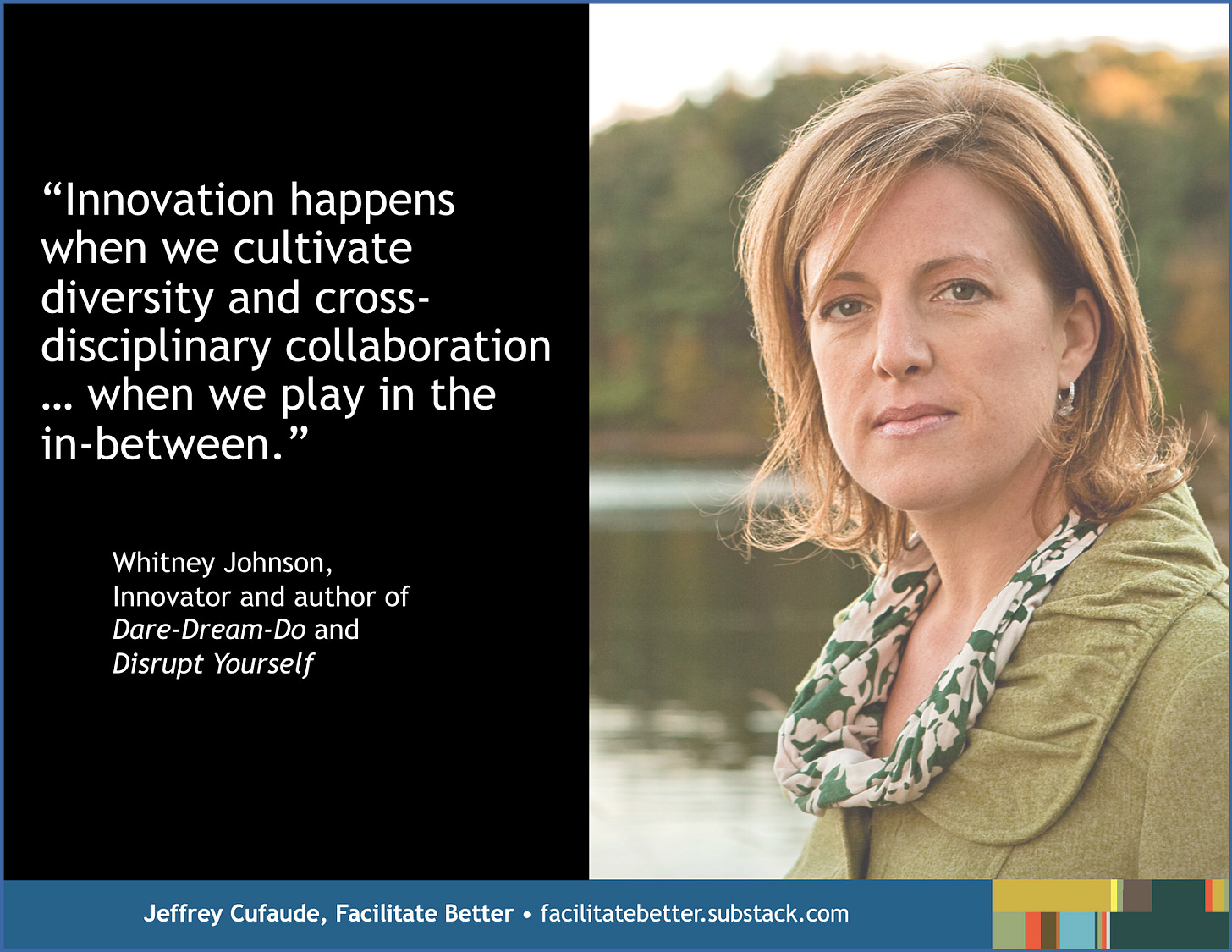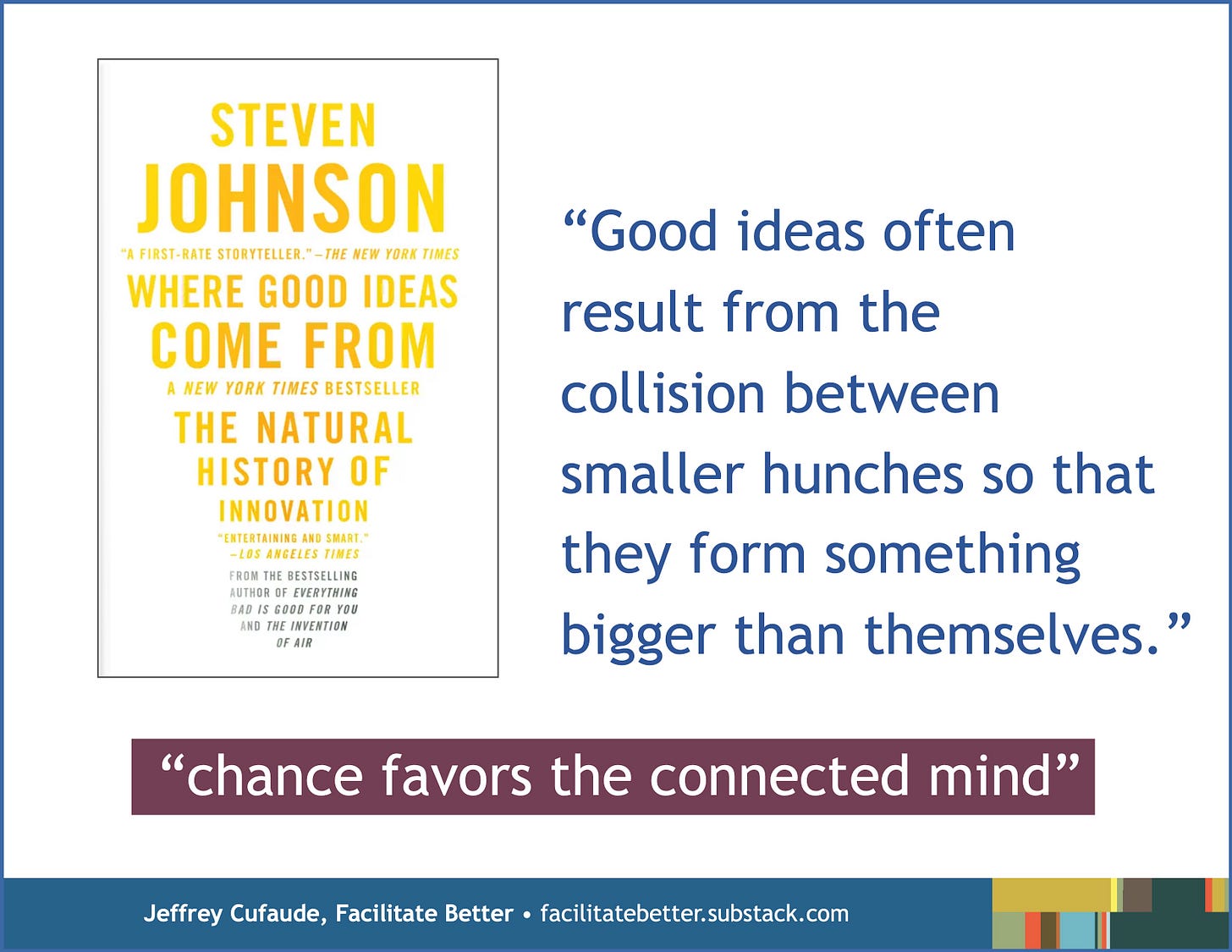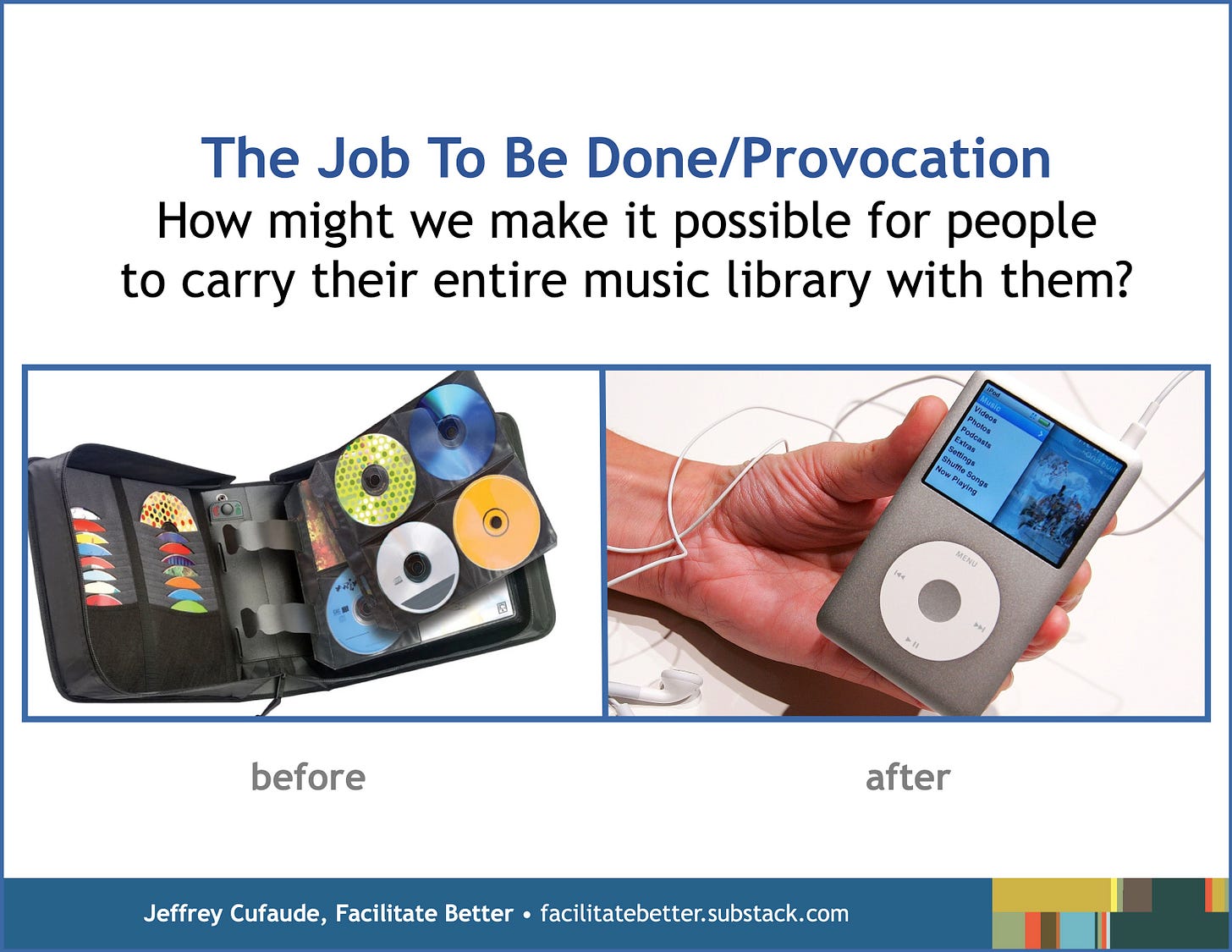Seven Powerful Practices to Facilitate Fresh Thinking and New Ideas (Facilitation Friday #68)
It may be time to rethink and/or refresh how you make it easier for participants to produce fresh thinking and new ideas.
What helps make it easier for a facilitated session to produce fresh thinking and ideas?
As more organizations focus on innovation, facilitators must possess practical answers to this question and be capable of designing and facilitating sessions that apply them. Doing so is helped when we have:
knowledge of the relationship between creativity and innovation;
familiarity with the discipline of design thinking, its principles, and its practices; and
an understanding of ideation and rapid prototyping processes.
These areas are vital to helping individuals and groups move through the three thinking stages required to produce innovative solutions and products: (1) creative (2) critical, and (3) constructive.
Here are seven useful facilitation practices for creative thinking stage efforts when people explore what is desirable, generate fresh thinking, and brainstorm new ideas.
1. Use environments conducive to expansive thinking.
Kurt Lewin postulated that behavior is a function of people interacting with the environment. Change the environment and people’s behavior will change. We should always select and/or create settings most conducive to a session’s outcomes.
Stimulating fresh thinking can occur more easily in environs that offer ample indoor and outdoor multi-purpose spaces, flexible configurations, windows and natural light, lots of whiteboards and walls for posting ideas, and comfortable and movable furniture. In short, you want an environment not commonly found in hotels, although that is slowly changing.
Conference centers are better sometimes, but you may have more success choosing a non-traditional venue: an art gallery or museum, a maker’s space, a meeting pavilion in a park, an ad agency's meeting spaces, an open room in an artists' warehouse, or even a primary school (hey, it's where we last played with unbridled creativity).
2. Diversify participants and perspectives.
The environment is important, but let's not forget the other key ingredient in Lewin's formula: the people. Research shows a correlation between a group's diversity of perspectives and innovative results.
This applies not only to those in the session, but also to others whose pre-session input or post-session feedback on draft output might be sought. A thoughtful mix of interdisciplinary participants and perspectives make it easier to leverage cross-disciplinary conversations that often produce innovative insights.
Whose input can you include to expand the natural thinking and viewpoints of those involved in the session?
What perspectives or participants from outside the organizations, disciplines, industries, professions, and/or geographic locations of those in the session could help produce the gathering’s outcomes?
Who are worthwhile wild cards ... the unusual suspects ... who could shake up the conversation if contributing to it?
As one example, I previously shared how I have experimented with “real-time reactors” to improve the quality of strategic planning discussions rather than waiting for final output before soliciting feedback.
3. Help hunches and incomplete ideas collide and connect.
As Steven Johnson notes in his book, Where Good Ideas Come From, "Good ideas often result from the collision between smaller hunches so that they form something bigger than themselves."
Effective facilitation needs to helps surface participants’ hunches so that they can collide with others' thinking and perhaps lead to different, bigger, and/or better ideas. This requires creating and maintaining an equitable, inclusive, and safe climate where people feel comfortable “thinking out loud” and sharing partially formed thoughts. Here are two tactical tips that can help:
Set a challenging goal for the # of ideas to generate and an initial aggressive timeframe for doing so; i.e. “Let’s generate 100 ideas in 10 minutes.” The specific target and time constraint often enable participants to share more freely and self-censor less.
Instead of capturing others' ideas yourself, stock the room with sheets of paper, notecards, jumbo post-its, and a variety of pens and markers and ask participants to note their own ideas and post them appropriately. This allows you to focus exclusively on managing the conversation. If online, provide simple tools for participants to post their own thinking.
4. Stimulate participants’ thinking with carefully curated pre-work.
A well-designed creative thinking session facilitates meaningful connections among intentionally disparate participants and perspectives to yield new ideas and insights. As Steven Johnson explains in the short video below, “chance favors the connected mind.”
Even diverse participants benefit from a bit of mental stimulation or cognitive dissonance. Ensure your session previews and pre-work offer alternative viewpoints or disrupt conventional wisdom to further expand participants’ perspectives:
Have participants scan the feeds from interesting individuals or relevant hashtags on social channels and capture insights to share.
Assign them a thought leader to interview and report on at the actual meeting.
Expose participants to data that may interrupt their biases or preconceived notions.
Send them on online field trips to sites/links you provide that may challenge their thinking or offer tangible examples of different ways of being or doing related to the session’s outcomes.
5. Engage participants in field research.
Peter Drucker asserted that innovation “creates a new dimension of performance or value.” To gain insight into what customers, members, and other stakeholders might value, involve participants whenever possible in pre-work that includes actual observation of the target audience in action.
They should notice and record patterns of behavior observed, frustrations that end users work around, shortcuts they use to get what they need, or aspirations they may not express in survey responses.
Why? As Gary Hamel suggests, "innovation often results from insight into the unarticulated need." Acting as anthropologists and using observational research can help creative thinking session participants unearth these unarticulated needs.
6. Use provocations or disruptive hypotheses to stimulate fresh thinking.
These statements help participants consider ideas, questions, or lines of thought that may seem unreasonable given present reality. Doing so often yields the breakthrough thinking that dramatically escalates the value of a product, program, or service.
Focus the provocations or disruptive hypotheses on what is desirable, not what is doable. The latter gets addressed in the critical and constructive thinking stages.
Example: Once upon a time, if people wanted their music with them on a trip, they had to select a dozen or so CDs to carry. But then someone asked the provocative question that challenged that practice, focused on a new Job To Be Done, and led to the invention of the mp3 player: How might we make it possible for people to carry their entire music library with them?
Crazy talk, right? But the ideas generated ultimately led to one of the most globally ubiquitous products in years.
7. Draw on a variety of techniques and activities to engage participants in different thinking.
In the creative thinking stage of the innovation process, I find it beneficial to churn the group process more, to use more varied exercises and activities to remix and recombine participants and their thinking. Doing so seems to maximize available time, energy, and interests in the most productive manner.
Three favorite resources I turn to are the:
exercises in Dan Pink’s book A Whole New Mind (full disclosure: I authored some of them)
Be sure the tools, techniques, or activities you select (and your facilitation of them) engage both introverted and extroverted thinkers.
Related:
Generating Better Ideas and More of Them (Facilitation Friday #29).
Bottom Line
Fostering creative thinking and innovative solutions is an increasingly common desired outcome for many meetings and planning sessions. Don’t assume that people can just show up and the supposed lightning in a bottle magically will be released. Successful design and facilitation of these efforts often requires rethinking and/or refreshing how we approach making it easier for participants to offer fresh thinking and new ideas.
Getting in Action
Consider Kurt Lewin’s axiom that behavior is a function of people interacting with the environment. Identify a few doable changes to the environment of a meeting that you either attend or facilitate, ones more likely to elicit participant behaviors that help achieve the gathering’s outcomes. Experiment with these changes as much as you can.
Imagine you are facilitating a meeting convened to generate ideas for a new program or service related to a specific identified need. What pre-work or field research (in general) might you assign to help prepare participants to think differently?
Think of an area in your personal, professional, or volunteer endeavors where new ideas are often needed. Generate a few provocative questions that might disrupt existing perspectives and/or inspire fresh thinking and interesting possibilities.
© Facilitate Better and Jeffrey Cufaude. All rights reserved.
To affordably license this content for reprint on your site or in electronic or print communications or to contact me regarding customized facilitation skills workshops or consultations, complete this form.
View draft history









This post is just packed with ideas, so thank you for that! I love the concept of "small hunches" coming together to produce big ideas and I plan to use that in an upcoming leadership retreat I am facilitating! Thank for continuing to share your wisdom!
You are most welcome. I am so glad the post resonated with you. Here is a link to a PDF with two sample hunch cards I've used at different leadership retreats.
https://www.dropbox.com/scl/fi/5g67911hngsm9w4q206g4/sample-hunches.pdf?rlkey=xea3iyabxcgd4xmrhlmo9grnb&st=a5hqyj0n&dl=0
Sometimes I have people share hunches at the start as a conversation catalyst. Other times I use the technique during the session as a way to distill conversations into something potentially actionable.